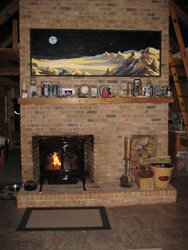I recently installed a Jotul F 600 in front of my fireplace on a hearth extension that is raised nine inches above my floor level. Here is a photo:

The hearth extension extends 17" from the fireplace and the stove front sits just two inches from the front edge. I plan to do all my loading through the side door and do not plan on ever opening the front doors while burning. I'll only open the front doors on occasion to clean the glass when the stove is cold. My floor is a floating laminate that is made of a combustible material (although it is fairly hard to catch fire). Presently, I just have the hearth rug in front of the stove that I used with my old insert. It protects against embers. With this arrangement I'm not sure what my requirement is for clearance in front of the stove. I've read in multiple threads here at the forum that stoves on raised hearths meet the 16" front clearance requirement by being on the raised hearth and only need ember protection out front. Is this true, or do I actually need to put down a fireproof pad of some sort in front of my hearth extension. I'm not too concerned about the actual safety since there is no chance of something hot falling out the front and my side door has about five feet of brick in front of it.

The hearth extension extends 17" from the fireplace and the stove front sits just two inches from the front edge. I plan to do all my loading through the side door and do not plan on ever opening the front doors while burning. I'll only open the front doors on occasion to clean the glass when the stove is cold. My floor is a floating laminate that is made of a combustible material (although it is fairly hard to catch fire). Presently, I just have the hearth rug in front of the stove that I used with my old insert. It protects against embers. With this arrangement I'm not sure what my requirement is for clearance in front of the stove. I've read in multiple threads here at the forum that stoves on raised hearths meet the 16" front clearance requirement by being on the raised hearth and only need ember protection out front. Is this true, or do I actually need to put down a fireproof pad of some sort in front of my hearth extension. I'm not too concerned about the actual safety since there is no chance of something hot falling out the front and my side door has about five feet of brick in front of it.

